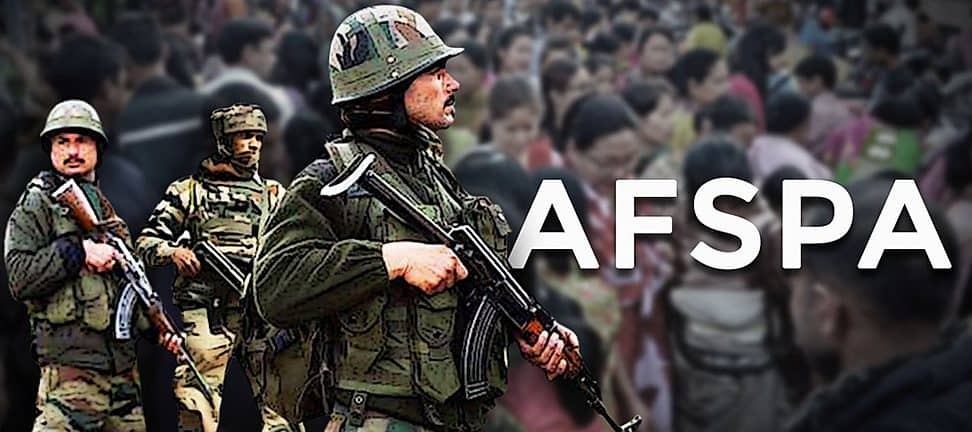Introduction
The Armed Forces Special Powers Act (AFSPA) marked a pivotal moment in India’s approach to internal security and conflict resolution. Initially enacted in 1958 against the backdrop of insurgency in the northeastern states, AFSPA emerged as a response to the challenges posed by armed rebellion and separatist movements.
And also Its inception reflected the government’s perceived need for a robust legal framework to empower security forces in quelling unrest and maintaining law and order.
Furthermore, the introduction of AFSPA signaled a departure from conventional policing methods towards a more militarized approach to counterinsurgency operations.
Thus, the introduction of AFSPA marked the beginning of a contentious chapter in India’s history, characterized by debates over the balance between state authority and individual rights in conflict-affected regions.
. The British colonial government had on August 15, 1942, promulgated the Armed Force Special Powers (AFSPA) Ordinance to suppress the Quit India Movement.
. “Assam disturbed areas” was invoked in 1947 to deal with Partition-induced internal security challenges.

The Armed Force (Assam and Manipur ) Special Powers Act, 1958
. Firstly, The Assam government implemented the Assam Maintenance of Public Order in Naga Hills in 1953 to address insurgents. The Assam Disturbed Areas Act of 1955 provided a legal framework, and Assam Rifles were sent to fight the insurgency in Naga Hills.
. Secondly, The Naga uprising, led by the Assam Rifles, led to the establishment of the Federal Government of Nagaland in 1956, allowing only the Governors of States and Executives of Union Territories to report locations.
The Special Powers of the Armed Forces (Punjab and Chandigarh) Act, 1983
. The Armed Forces (Punjab and Chandigarh) Special Powers Act was passed in 1983, allowing central military forces to conduct operations in the State of Punjab and the union territory of Chandigarh. The legislation remained largely unchanged, with Section 4 amending to allow forcible vehicle stops and searches.
. The High Court invalidated Section 5, which will enable soldiers to unlock locks withheld by the key to it, despite the Act’s 14-year existence in Chandigarh.
. The AFSPA replaced the Act for wider application. In September 1990, the government passed the Armed Forces (Jammu and Kashmir) Special Powers Act, a legislation specifically tailored for Jammu and Kashmir. They may implement this act if the Central Government or the Governor of Jammu and Kashmir believes that all or a portion of the Union Territory is in such a chaotic and hazardous state or weaponry.
How is AFSPA Implemented?

. Moreover the Section 3 of the AFSPA empowers the Governor of a state and the administrator of a Union Territory (UT) to declare an area “disturbed” and issue an official notification in The Gazette of India to give the center the authority to deploy the “armed Forces in aid of the civil power “
What is a Disturbed Area?
. A government considers an area “ disturbed “ if it perceives a threat to “ public peace and tranquility, because of differences or disputes between members of different religious, racial, language or regional groups or castes or communities.
. The situation is reviewed periodically for an extension for extension of the AFSPA.
Implication of AFSPA
. It says any commissioned officer, warrant officer, non-commissioned officer, or any other person of equivalent rank in the armed forces can for the maintenance of public order “ fire upon or otherwise use force” after giving such due warning as he may consider necessary.

The Act allegedly grants unbridled power to the armed forces and the Central Armed Police Force deployed in “disturbed areas” to kill anyone.
Thus, acting in contravention of the law, arrest and search any premises without a warrant, and protects from prosecution and legal suits without the Central government’s sanction.
LIMITATION ON AFSPA
. While the Act gives power to security forces to open fire, this cannot be done without prior warning given to the suspect.
. It says that after the apprehension of suspects, the security force has to hand them over to the local police station within 24 hours.
. It says also the armed forces must act in cooperation with the district administration and not as an independent body.
SUPREME COURT VIEW ON AFSPA

-In Naga People’s Movement of Human Rights v Union of India, 1997
– Upheld the law
– State administration view is important
– Law should be implemented temporarily
– Army force should use force cautiously
. In 2016 a verdict by a bench of Justice Madan Lokur and U U Lalit stated that there is no concept of absolute immunity from trial.
CRITICISM OF AFSPA
. “ License to kill”
. A tool of state abuse, oppression, and discrimination.
Therefore, The nation that broke free from colonial rule, continues to use the same laws used by a foreign power on its subjects.
. The United Nations has often pointed out it has no place in Indian democracy.
. And also It is against individual freedom and human dignity.
. This has led to psychological consequences, trauma, and alienation of the people.
Argument in Favour of AFSPA
. Essential in protecting the border.
. Ensures security in disturbed area
. Also Effective in countering insurgency and extremist forces. Sufficient Power for armed forces to tackle the challenges faced by the nation
1• While acknowledging the controversies surrounding the Armed Forces Special Powers Act (AFSPA), it is essential to consider the arguments in favor of its continued existence.
2• Firstly, proponents argue that AFSPA provides necessary legal backing for security forces to effectively combat insurgency and maintain law and order in conflict-affected regions.
3• Moreover, they contend that the Act serves as a deterrent to anti-state elements, preventing further escalation of violence. Additionally, supporters of AFSPA emphasize the unique challenges faced by security personnel operating in volatile environments, highlighting the need for special powers to swiftly respond to threats to national security. 4.Furthermore, they assert that the presence of AFSPA is crucial for the protection of civilians, as it enables security forces to effectively neutralize terrorist threats and safeguard public safety.
• Overall, advocates of AFSPA argue that its retention is essential for preserving stability and ensuring the safety of both citizens and security personnel in areas plagued by insurgency and unrest.
What is the present status of AFSPA?

. Currently, AFSPA is enforced in J&K, Assam, Nagaland, and parts of Arunachal Pradesh and Manipur.
. Governments often repeal the law in areas where insurgencies have diminished and where they have developed confidence in managing the region with their police force.
. Despite periodic calls for its repeal or amendment, AFSPA continues to be in force in certain regions of India, particularly in areas affected by insurgency and internal conflict.
. The centre removed AFSPA from Tripura a Meghalaya in 2015 and 2018 respectively.
. The center also partially withdrew AFSPA from Arunachal Pradesh.
In April 2018, Meghalaya withdrew the Act from a 20-km area along the 885-km boundary with Assam.
Also In 2004, Manipur withdrew the Armed Forces Special Powers Act (AFSPA) from seven Assembly constituencies surrounding the State capital, Imphal. This decision came amidst upheaval sparked by the custodial death of a woman, who was considered an extremist.
Tripura in 2015.
- The killing of 14 villagers in Oting, Mon, in Nagaland has significantly revived the demand to repeal AFSPA.
2. In Manipur, insurgency as well as heavy militarisation have been on the decline since 2012, when the Supreme Court started hearing a PIL on extra-judicial killings.
3. As well as , In Nagaland, all major groups – the NSCN(I-M) and Naga National Political Groups (NNPGs) – are at advanced stages of concluding agreements with the government.
Conclusion
In conclusion, the history of the Armed Forces Special Powers Act (AFSPA) reflects a contentious legacy marked by its implementation in regions of conflict and insurgency.
Introduced during a period of unrest, AFSPA granted sweeping powers to security forces, leading to allegations of human rights abuses and violations.
Thus, Over time, its application has sparked debates regarding its necessity, effectiveness, and implications for democracy and civil liberties.
While proponents argue for its role in maintaining law and order in volatile regions, critics highlight its potential for misuse and advocate for its repeal or reform.
Also, The ongoing discourse surrounding AFSPA underscores the complex intersection of security, governance, and human rights in conflict-affected areas.



